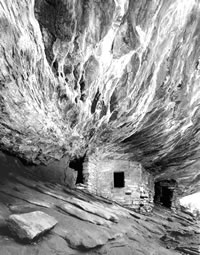| Moab Utah artists. Moab is home to many local artists and nationally known artists. These talented people work in a range of mediums from visual arts through literary to musical. Each month Moab Happenings features one of our talented local Moab artists. Artist of the Month - December 2003 Bruce Hucko: Following
the Path |
|||||
Bruce Hucko,-
photographer, author, educator, radio producer, and beloved
art coach,- is a multi faceted gemstone. Each of his facets
is easily worth a full article. He gave me quite a task,
relating the ‘cliff notes’ version of his
life and challenging me to shape it into 800 words which
express the depth and complexity of his art, his process,
and his contribution.
At the conclusion of
the workshop, Hucko asked the principal if there were
any jobs available. There was one-as a kindergarten aid.
Serendipity struck and the two-week workshop turned into
a ten-year, life changing commitment. After three years,
Hucko became a full time Artist-in-Residence in Montezuma
Creek through the Utah Arts Council. During his tenure
Hucko taught elementary students the principles of art
making and the basics of photography and set them loose
to create art from their own imaginations. For his efforts
the school received a 1984 Rockefeller Bros. Fund Award
for Excellence in Arts Education.
Hucko took the job, moved to Santa Fe, but soon left to become the art coach to the children in the Santa Clara, San Ildelfonso, and San Juan Pueblo Day schools. This led to his second book of children’s art, Where There Is No Name For Art. It was written and illustrated by the Tewa Pueblo children in collaboration with Hucko. Of the numerous books Hucko has to his credit this book is my favorite. Where There is No Name for Art expresses the beauty, imagination, and cultural traditions of the Tewa Pueblo people through the eyes and voices of its children. For this book Hucko received a Southwest Book Award. The time spent with Pueblo, Navajo and other tribal people has instilled in him the importance of the relationship between people and place, a theme found in all of his work.
Serendipity led Hucko
back to Moab to live and is sending him back to Montezuma
Creek. He has just received a $10,000 grant from the University
of Utah Center for Documentary Studies to study, through
photographs and interviews, the changing lives of his,
now adult, students.
The color and Black & White images I saw were taken with a view camera.. His images capture the abstract poetry and composition of the landscape. Regarding his photographic
work Hucko said, “like my poet friends, I like to
get the lines right.” Although said in jest, it
is clear that Hucko’s creative vision is like that
of a poet. He attempts, through an interplay of lines,
shapes, and values, to capture the universal essence of
his subject. Often his work, although literal and photographic,
appears non-objective and therefore is about the heart
of art and creative expression in and of itself. |
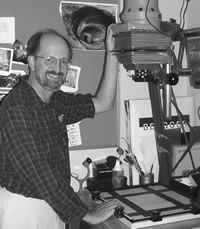
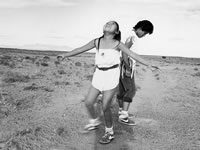
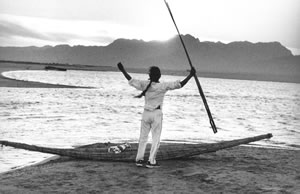 A
Seri Indian Shaman sings down the sun.
A
Seri Indian Shaman sings down the sun.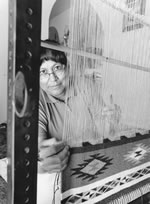 Navajo
Weaver Maxine Tsinnie of Eyedazzler project
Navajo
Weaver Maxine Tsinnie of Eyedazzler project